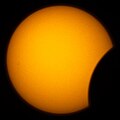Astrofotografi
Astrofotografi adalah sebuah jenis khusus dari fotografi yang memerlukan gambar pencatatan objek astronomi dan daerah besar di langit malam. Foto pertama dari objek astronomi (Bulan) diambil pada tahun 1840, tetapi tidak sampai akhir abad ke-19 bahwa kemajuan teknologi memungkinkan untuk fotografi bintang yang lebih rinci. Selain mampu merekam secara detail benda seperti Bulan, Matahari, dan planet-planet, astrophotography memiliki kemampuan untuk merekam objek gambar tidak terlihat oleh mata manusia seperti bintang redup, nebula, dan galaksi. Hal ini dilakukan oleh paparan lama sejak kedua film dan kamera digital dapat menumpuk dan jumlah foton cahaya selama ini jangka waktu yang lama. Dalam penelitian astronomi profesional, fotografi merevolusi lapangan, dengan eksposur lama merekam ratusan ribu bintang baru dan nebula yang tak terlihat oleh mata manusia, yang mengarah ke teleskop optik khusus dan semakin besar yang pada dasarnya besar "kamera" yang dirancang untuk mengumpulkan cahaya untuk direkam pada film. Astrophotography langsung memiliki peran awal dalam survei langit dan klasifikasi bintang tetapi seiring waktu itu telah memberikan cara untuk peralatan yang lebih canggih dan teknik yang dirancang untuk bidang tertentu penelitian ilmiah, dengan film (dan kemudian astronomi kamera CCD) menjadi hanya salah satu dari banyak bentuk sensor.
Astrophotography adalah sub-disiplin besar dalam astronomi amatir di mana biasanya digunakan untuk merekam gambar estetis, bukan untuk penelitian ilmiah, dengan berbagai macam peralatan dan teknik yang didedikasikan untuk kegiatan tersebut.
Contoh teknis astrofotografi amatir
-
 Fixed tripod mounted camera star trails
Fixed tripod mounted camera star trails -
 Star trails photographed in earth orbit from the International Space Station
Star trails photographed in earth orbit from the International Space Station -
 Fixed tripod image of a solar eclipse using a digital-SLR camera with a 500 mm lens
Fixed tripod image of a solar eclipse using a digital-SLR camera with a 500 mm lens -
 1 minute exposure using ISO 800 film, wide angle lens, piggybacked on an equatorial telescope
1 minute exposure using ISO 800 film, wide angle lens, piggybacked on an equatorial telescope -
 Comet Hale-Bopp, camera with a 300mm lens piggybacked
Comet Hale-Bopp, camera with a 300mm lens piggybacked -
 Film image of the Andromeda Galaxy shot at the prime focus of an 8" f/4 Schmidt–Newton telescope
Film image of the Andromeda Galaxy shot at the prime focus of an 8" f/4 Schmidt–Newton telescope -
 Lagoon and Trifid Nebulae in a montage of two single 30-minute exposures captured on slide film at prime focus of an 8" Schmidt–Newton telescope. The telescope was manually guided during exposure with an 80mm / 910mm f.l. refractor guide scope
Lagoon and Trifid Nebulae in a montage of two single 30-minute exposures captured on slide film at prime focus of an 8" Schmidt–Newton telescope. The telescope was manually guided during exposure with an 80mm / 910mm f.l. refractor guide scope - Image of the moon taken with a Nikon Coolpix P5000 digital camera via Afocal projection through an 8 inch Schmidt–Cassegrain telescope
-
 The Moon photographed using the Afocal technique, using 10 seconds of video stacked to create a final image.
The Moon photographed using the Afocal technique, using 10 seconds of video stacked to create a final image. -
 A composite of several Digital-SLR photos compiled in Photoshop taken via eyepiece projection from an 8 inch Schmidt Cassegrain telescope.
A composite of several Digital-SLR photos compiled in Photoshop taken via eyepiece projection from an 8 inch Schmidt Cassegrain telescope. -
 Saturn photographed using negative projection (Barlow lens) with a Philips Tou Webcam attached to a 250mm Newtonian telescope. It is a composite images made from 10% of the best exposures out of 1200 images using freeware image stacking and sharpening software (Giotto)
Saturn photographed using negative projection (Barlow lens) with a Philips Tou Webcam attached to a 250mm Newtonian telescope. It is a composite images made from 10% of the best exposures out of 1200 images using freeware image stacking and sharpening software (Giotto) -
 Jupiter photographed using the Afocal technique, using 10 seconds of video stacked to create a final image.
Jupiter photographed using the Afocal technique, using 10 seconds of video stacked to create a final image.
Referensi
Pranala luar
| Cari tahu mengenai Astrofotografi pada proyek-proyek Wikimedia lainnya: | |
 | Definisi dan terjemahan dari Wiktionary |
 | Gambar dan media dari Commons |
 | Berita dari Wikinews |
 | Kutipan dari Wikiquote |
 | Teks sumber dari Wikisource |
 | Buku dari Wikibuku |
- Astrophotography - The Amateur Connection, The Roles of Photography in Professional Astronomy, Challenges and Changes Diarsipkan 2017-05-29 di Wayback Machine.
- Henry Draper's Photograph of the Moon, 1863 on Cyanotype Diarsipkan 2011-10-04 di Wayback Machine.
- History of Astrophotography Timeline - 1800-1860 Diarsipkan 2012-04-22 di Wayback Machine., 1861-1900 Diarsipkan 2013-01-17 di Archive.is Diarsipkan 2013-01-17 di Archive.is
- One of the first photos of the Sun (taken in 1845)
- Peter Abrahams: The Early History of Astrophotography
- Ricky Leon Murphy: CCD's Versus Professional Plate Film (astronomyonline.org)
- The History of Astrophotography (astrosurf.com)
- Astrophotography Techniques - Astropix.com
- Description of the types of images used in astrophotography. Diarsipkan 2014-02-01 di Wayback Machine.





















